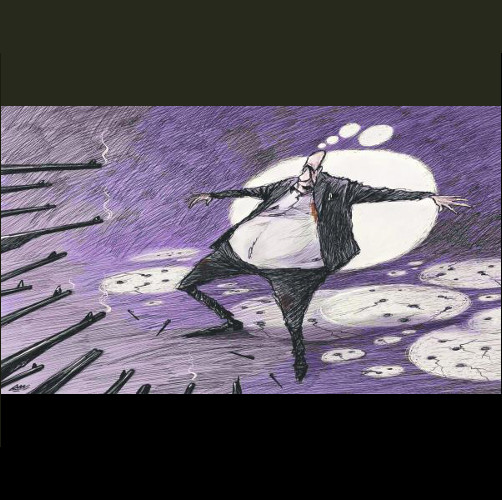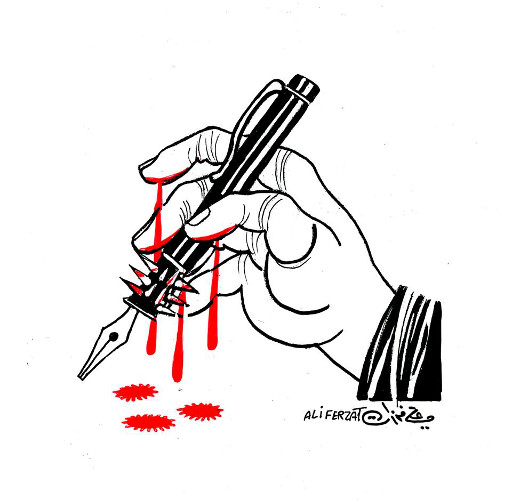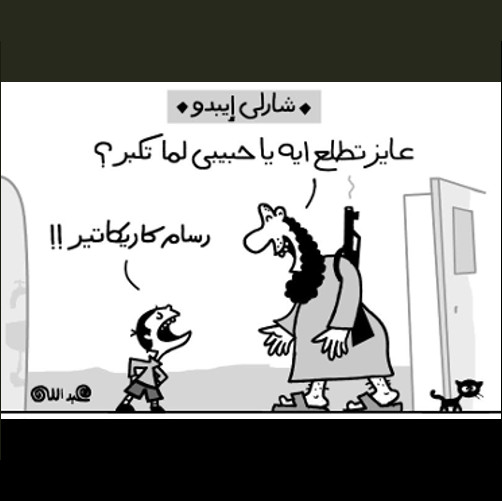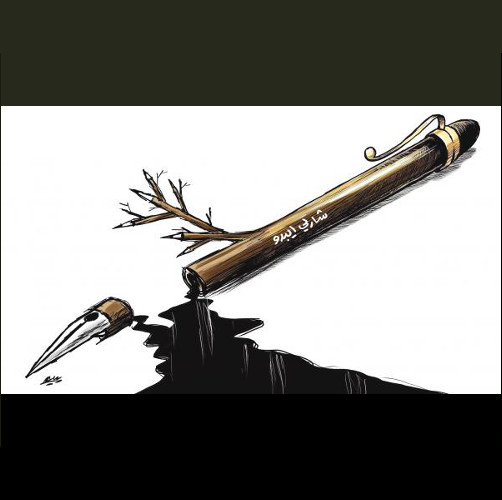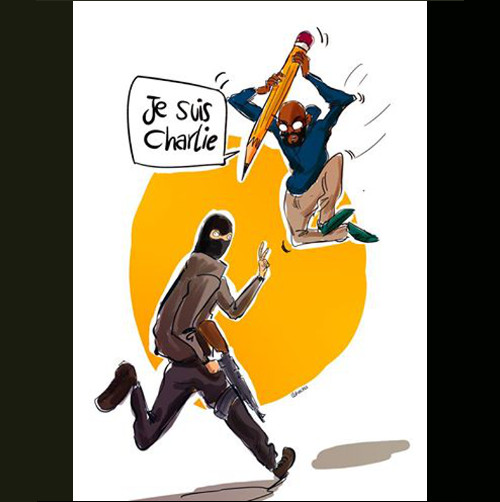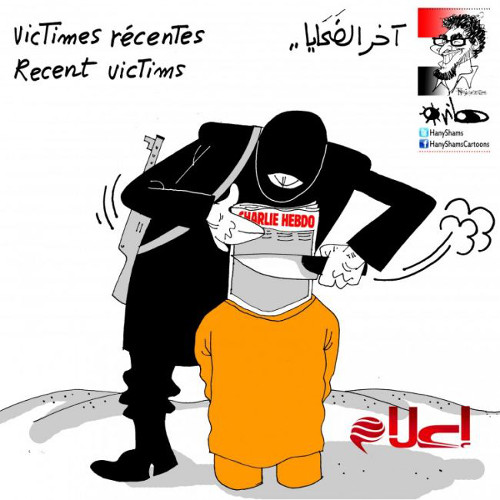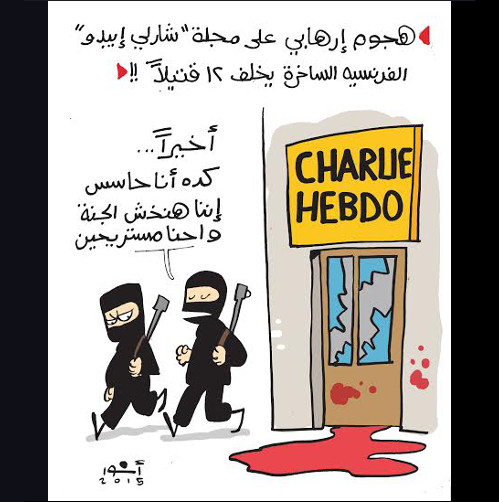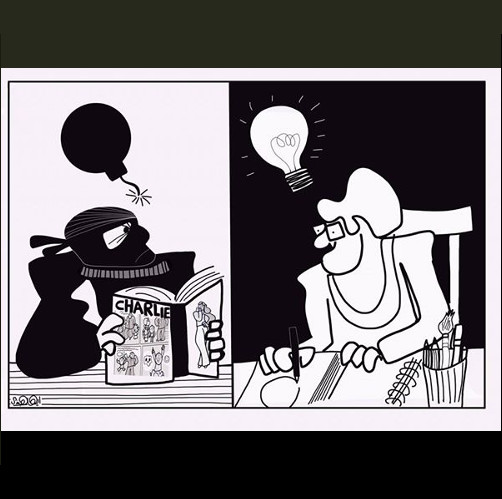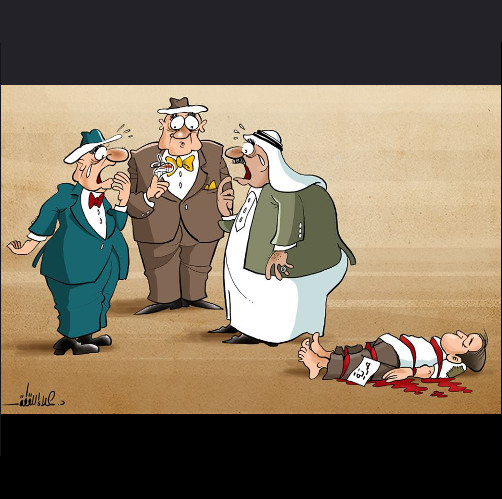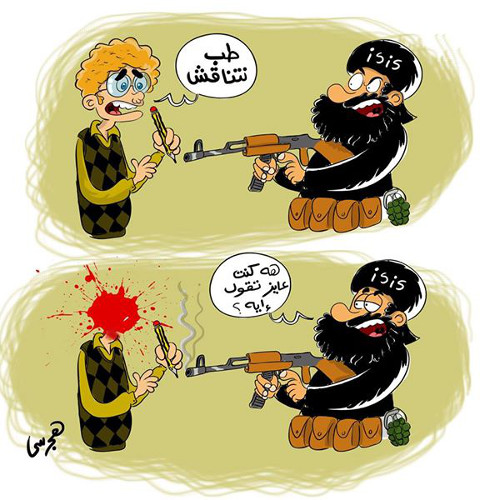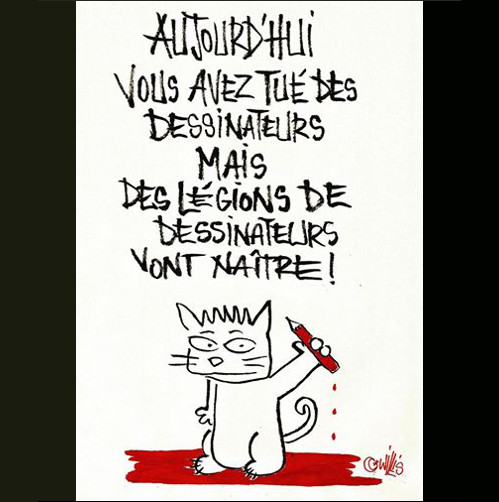9. Alaa Allagta, January 9, 2015 “Freedom,” reads the sign by the mangled child on the ground. Allagta, a Palestinian cartoonist and surgeon living in Gaza, denounces the attacks in Paris in this cartoon while lamenting that the plight of Arabs does not receive the same media coverage as a massacre. “Yesterday, fifteen children died in Syria and two in the Gaza Strip because of the cold,” Allagta told me. “What kind of the civilized world is this?!!”
By Jonathan Guyer
The satirist Yaacob Sannu, an Egyptian Jew with Italian roots, is credited with illustrating the first Arabic comics for the Egyptian satirical magazine Abu Naddara (“The Man with the Glasses”), which he founded in Egypt in 1877. An anti-colonial crusader as well as a journalist and fiction writer, Sannu’s irreverent lens on the world and his mockery of Egyptian leader Khedive Ismail forced him into exile, with copies of his comic broadsheet remaining available in Egypt afterward only once getting smuggled from France.
A similar tension between cartoonists and the authorities endures to this day in the region. Indeed, cartoonists across the Middle East have been punished for expressing audacious views in their illustrations. In Egypt, Palestine, Syria, and Turkey, comic attacks on the powerful have been met with violence. Across the Middle East, each state has laws that restrain free speech, and artists skirt around these parameters, which are haphazardly enforced. Cartoonists never know if they have gone too far until they confront backlash.
It’s not just ISIS that has threatened artists. Blasphemy is a legal charge that Arab cartoonists have been deflecting for years.
The counterattacks come from state institutions, government supporters, religious advocacy groups, terror networks, and more. Governments and extremists (both secular and religious) monitor social media for offending art. Last fall, ISIS issued death threats against Kuwati comic book artist Naif Al-Mutawa, who created The 99, a popular series that explores the ninety-nine attributes of Allah from the Quran, each through a singular superhero. But it’s not just ISIS that has threatened artists. Blasphemy is a legal charge that Arab cartoonists have been deflecting for years.
The threat of being sued for blasphemy has been used to chill free speech. In Egypt, during the presidency of the Muslim Brotherhood-affiliated Mohammed Morsi, the Human Rights Committee of the Lawyers Syndicate used their power to crack down on satirists. In December 2012, Salafi attorneys brought lawsuits against cartoonist Doaa Eladl. In April 2013, they targeted the biting jokes of star comedian Bassem Youssef. Both Eladl and Youssef also received death threats.
In the major Egyptian newspaper Al-Shorouk, Youssef—who has been called Egypt’s Jon Stewart—wrote a column on “How to Face Religious Extortion.” Youssef’s message to the ultra-religious, who saw his humor as an insult to Islam, was blunt: “I’m sorry, but when I look at you, what I see is your morals, which have no relationship to God’s law. We don’t hate God; we cannot. We just can’t stand you.” While Youssef dodged that lawsuit and other legal trouble, last year he decided to cancel his popular prime-time show, The Program, in response to the pro-military fervor that had shrunken the space for parody. Secular governments sometimes have as little tolerance for free speech as the religious.
If cartoonists aren’t subject to legal threats, they’re often put in physical danger. When Gaza-based illustrator Majda Shahin drew a beleaguered Prime Minister Ismail Haniyeh on her Facebook page last year, the response from Hamas supporters was death threats. The Cartoonists Rights Network International recognized her with its Courage Award. “It is not a simple matter for a woman like me to express my opinions with such clarity, particularly when these opinions don’t coincide with those of the current rulers, the Hamas movement,” Shahin said to the group in her prepared acceptance speech. (She was unable to travel to the U.S.).
In 2011, President Bashar Al-Assad’s goons battered the Syrian cartoonist Ali Ferzat, leaving him with two broken arms. Just as chilling is the case of the twenty-nine-year-old Syrian cartoonist Akram Raslan, who was abducted in October 2012 and remains missing. Conflicting reports abound about whether the Al-Assad regime has slain Raslan.
All leaders, it seems, are sensitive to being the butt of jokes.
Even in quasi-democracies, like Turkey, cartoonists are not afforded broad rights. An attorney for the Turkish President Recep Tayyip Erdogan has targeted cartoonist Musa Kart. Another Turkish cartoonist, Mehmet Düzenli, spent three months in jail for mocking religion, earlier this year. And in 2013, Israel detained Palestinian caricaturist Mohammad Saba’aneh, of Jenin, ultimately sentencing him to five months in prison. All leaders, it seems, are sensitive to being the butt of jokes.
Given the tense environment in which Mideast cartoonists operate, their outcry of support for Paris’s slain is based on a shared experience. Scores of Arab cartoonists—in illustrations, interviews and written statements—have condemned the assassinations as indefensible and barbaric, even while censuring caricatures of the prophet and calling for respect for Islam. “This act constitutes a savage attack that cannot be glossed over or justified in any form or fashion,” the Iraqi Society of Cartoonists in Baghdad said in a statement, in Arabic. “Regardless of our previous reservations about forms of expression that insult or disregard religious and cultural beliefs, and the tensions and sensitivities they provoke, cartoonists and journalists wield no ‘weapons’ other than their pens and their ideas.”
Furthermore, despite limitations on a variety of expression—notably insulting presidents or monotheistic religions—a new Golden Age of Arab cartoons is underway. The voices of Mideast cartoonists are anything but monochromatic. There are revolutionaries and conservatives, secularists and Islamists, women and men. In dozens of Arabic newspapers, teams of staff cartoonists publish daily. Radical comic zines and experimental graphic novels are gaining popularity in Egypt and Lebanon. On newsstands, Arab comic books for children offer Islamic teachings. Online, artists can avoid scrupulous editors and publish their works instantly, creating a space where memes and cartoons intermingle.
Arab cartoonists grapple everyday with determining what is an acceptable cartoon, and what the price might be for going too far.
The region’s cartoonists know that the risks of publishing bold caricatures can be deadly. They are well aware that confronting censorship, and working around it, is simply part of the job description, an obstacle that counter-intuitively fosters creativity. For Mideast cartoonists, speech and censorship are not necessarily in opposition with one another. The art form—its multiple levels of symbols, hidden messages, and exaggerations—thrives on ambiguity, as cartoonists set their own personal limits. And what I’ve discovered while researching comics is that censorship, strangely enough, enables risk taking. The funniest and most effective cartoons tack very closely to the unacceptable, and the red lines of the appropriate constantly shift.
For example, when drawing then-President Hosni Mubarak was off-limits, especially in the mid-2000s, Egyptian cartoonists forged workarounds—even as authorities cracked down on journalists who allegedly insulted the president. Illustrators started by drawing kings that had similar faces to the president, then the back of Mubarak’s head—a recognizable stubby neck—and over time were able to draw his face directly by slowly chipping away at the autocrat’s power. Today, drawing President Abdul-Fattah Al-Sisi is equally taboo. That hasn’t stopped vocal critics from caricaturing Al-Sisi, all while famous critics are sued and ostracized. They continue to draw under the intense pressures of violent, at times lethal, censorship.
Arab cartoonists grapple everyday with determining what is an acceptable cartoon, and what the price might be for going too far. Their shock in response to the Charlie Hebdo murders, then, has been visceral. Here are eleven cartoons from Syrian, Egyptian, Jordanian, Tunisian and Palestinian cartoonists on the tragic events.

